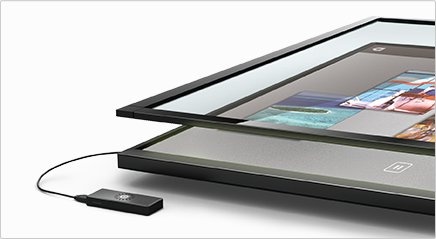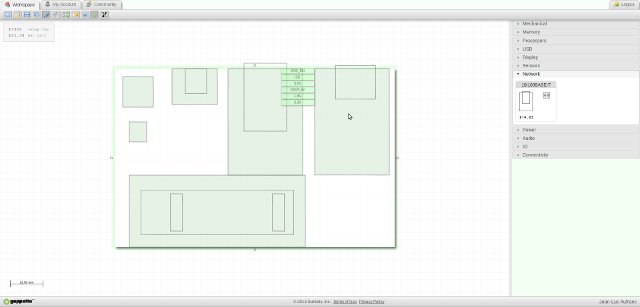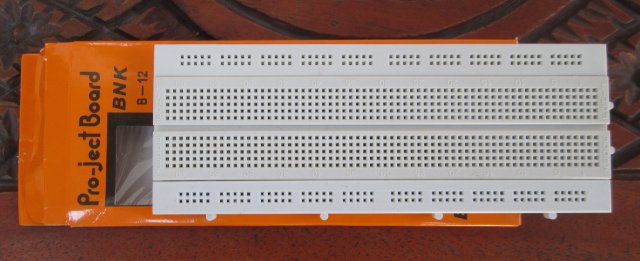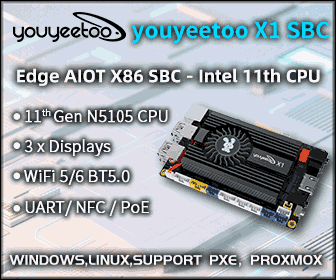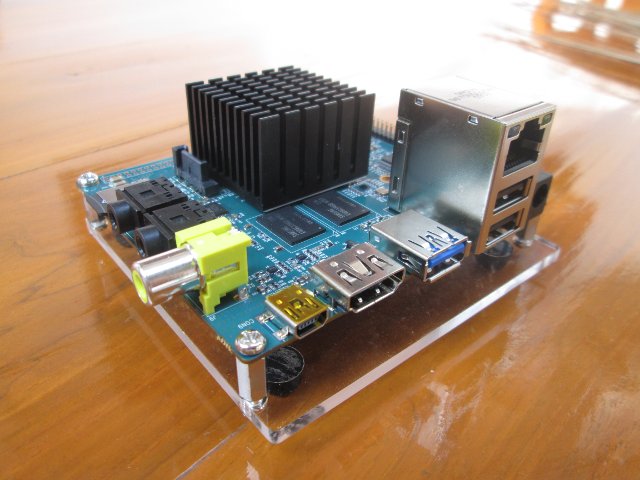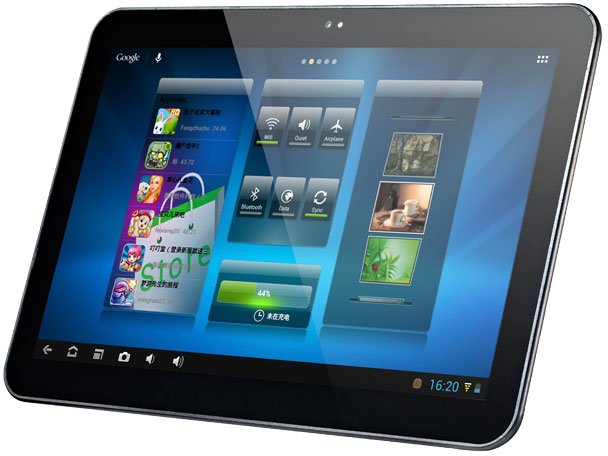PQ Labs iStick A200 is a Rockchip RK3066 Android 4.1.1 mini PC with 2 GB RAM, 4 GB Flash, an HDMI (female) output, a USB 2.0 Host port, and a miniUSB port for power. Pretty boring stuff if you ask me… And I would not be writing about it, if the company hadn’t interfaced their infrared touch frames to this mini PC to allow 10-point multi-touch on a large screen or projector output, making it a pretty good solution for conferences and interactive digital signage. Before going further, let’s have a look at the details of specifications for the iStick A200: SoC – ARM Cortex A9 Dual Core @ 1.6Ghz with HyperSpeed (Equivalent to 2.0Ghz Dual Core) and Quad Core Mali400 GPU (cnxsoft: It has to be Rockchip RK3066) System Memory – 2 GB DRAM chipset Storage – 4 GB NAND flash + microSD socket (Up to 32 GB) Video […]
ARM big.LITTLE Processing Demo (HMP) on ARM TC2 Test Chip
Samsung launched Exynos 5 Octa at CES 2013. This processor comes with 8 cores: 4 Cortex A15 cores and 4 Cortex A7 cores, and it’s the first processor that’s been announced to work in big.LITTLE configuration, where the big cores (A15) handle demanding tasks, and the LITTLE cores (A7) handle simpler tasks such as audio playback or background tasks. This is all done to optimize power consumption. There are 2 big.LITTLE software implementations: In-kernel switcher (IKS) and heterogeneous multi-processing (HMP). The first one is easier to implements but can only use 4 cores (in Exynos 5 Octa) at a time, and the second is more complex, but can handle all 8 cores, and assign individual tasks to a particular core. For more technical details about big.LITTLE implementations, you can read my previous post. ARM and Samsung recently uploaded a video providing an overview of big.LITTLE (but instead of IKS and […]
Gumstix Introduces Geppetto Web Platform to Design Custom Embedded Boards
Gumstix, the company behind the Overo computers-on-module (COMs), has recently announced an online platform called Geppetto that allows anybody with a proper web browser (e.g. Chrome or Firefox) to design and order a complete baseboard for the Overo COMs. You don’t need to know anything about schematics, PCB layout, or other lecrtical engineering knowledges. The program lets you set the board size, add modules (e.g. USB, HDMI, Ethernet…) as you wish, tells you which connections are required, and once the board is done, you can see your 3D rendered board. You can then save it to the cloud with an option to share it with the community, and you can just order it. The learning curve is very short, and once you know how to use it, it probably takes around 10 minutes to design a complete board. Your fearless CNXSoft had to give it a try… First, point your […]
Electronics Shop in Thailand – What Will $33 Buy?
Since I was in urgent need for a 5V/3A power adapter, I decided to go shopping locally (in Chiang Mai, Thailand) at some computer shopping malls, where they also have some spare parts. We spent about 1h30 visiting around 10 shops with no success: most of them did not have 5V power supply for sale, and those who did, could only provide 5V/2A power adapters. Finally, one guy at a shop was very helpful, and tried to help us without success, but finally he said you should go to “Amorn“, and after driving a few kilometers we got there. When I entered the shop I started to see some pretty interesting equipments: multi-meters, full sized oscilloscopes from 11,000 Bath (~370 USD), electronics cards for appliances (ventilators washing machine, car audio, amplifiers…), soldering irons, ribbon cables, components (capacitors, but no resistors), and much more. It turns out “Amorn Electronics Center” has […]
Open ARM GPU Drivers FOSDEM 2013 Video and Call to ARM Management
As I previously wrote, FOSDEM organizers are slowly uploading FOSDEM 2013 videos. One of the most interesting talk “Open ARM GPU Drivers” is now available. I’ve also uploaded it to YouTube (embedded below) to give it more exposure. Luc Verhaegen has also written a recent blog post entitled “Hey ARM!” where he announces the release of the modified source for Quake 3 Arena demo, and asks ARM to join them in making an open source driver. Open ARM GPU Drivers @ FOSDEM2013 This session covers the following key points: Problem – Binary drivers are mainly designed to run in Android, and it’s very difficult to have proper GPU drivers for Linux, and companies are not interested to release open source drivers or even just documentation, as they are not convinced it will benefit them in any way. Legal – This is actually the main issue, as open sourcing existing driver […]
Developer Community for Freescale i.MX6 HDMI Dongles
Last week, I explained how to build U-boot, the kernel, and Android for Freescale i.MX6 HDMI dongle reference platform. Since them, there has been a bit more activity, with Richtechie releasing source code to some ARMTvTech members. However, this source code is very similar to the one released by Freescale, and misses some part present in the kernel config on GK802 such as CONFIG_MACH_MX6Q_RICHTECHIE, and the company clearly does not comply with the GPL. Let’s forget that for now, as Jasbir (who is also behind the Hackberry board) has managed to build and boot the kernel on his mini PC. There’s still more work to do, but at least we have a based to work on. In the meantime, I’ve noticed rz2k, an other developer, was also giving it a try on #arm-netbook Freenode IRC channel, so we decided to setup a few things to facilitate development and communication between developers. […]
ARMBRIX Zero Cortex A15 Development Board Unboxing Pictures
I’ve just received an early sample of ARMBRIX Zero (aka ARMBRIX-5250-A), a development board based on Samsung Exynos 5250 dual cortex A15 processor with 2GB RAM, a microSD slot, 1x USB 3.0, 2x USB 2.0 Host, 1x USB Device, 10/100 Ethernet, HDMI output, SATA 3.0, some Audio I/O ports, and 3 expansions headers. This is basically a low cost version of the Arndale board, with things such as eMMC 4.5 (Sorry I’ve missed the eMMC socket at the back of the board) sensors missing. Today, I won’t turn the board on (I’ll explain why at the end of the post), but instead show some pictures of the development and debug boards. If you had previously seen the board picture before, you’ll noticed it has a grown a heatsink. The heatsink is probably here to stay, but may be slightly different (e.g. lower) when you receive your board. The bottom acrylic […]
Pipo Max M9 Android 4.1 Tablet Powered by Rockchip RK3188
I first heard about Rockchip RK3188 quad core Cortex A9 at the end of 2012, Rockchip showcased an RK3188 tablet development platform at CES 2013, and we were told the first tablet would ship in March without more details about available models. It appears Pipo Max M9 may be one of the first RK3188 available for purchase. This Android 4.1 tablet features a 10″ IPS display with 1280 x 800 resolution, 2 GB RAM, and 16 GB Flash. Here are the full specifications for PiPO MAX M9: SoC – Rockchip RK3188 Quad core Cortex A9 @ 1.8GHz with Mali-400MP4 GPU @ 533 MHz. System Memory – 2 GB RAM Storage – 16 GB flash + microSD slot Display – 10.1″ IPS display with 10-Point capacitive touch screen. Resolution: 1280 x 800 pixels Connectivity: Wi-Fi 802.11 b/g/n Bluetooth 2.1 3G via external USB dongle Camera – 2.0MP front camera, 5.0MP rear […]


